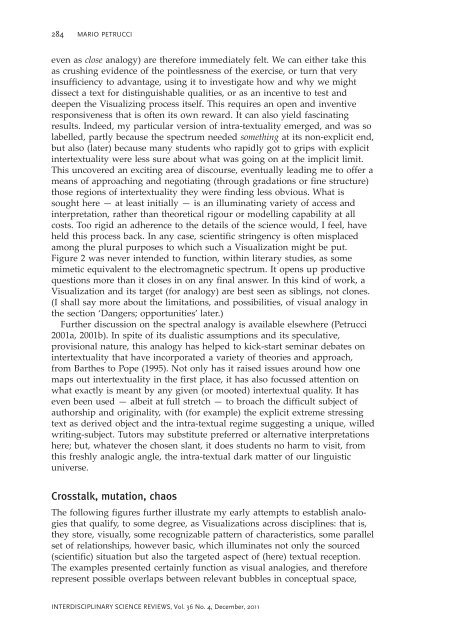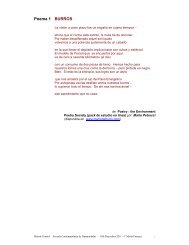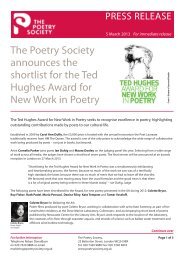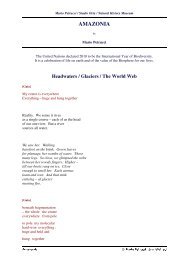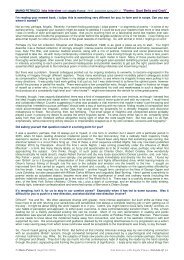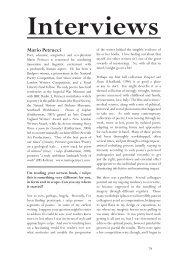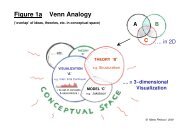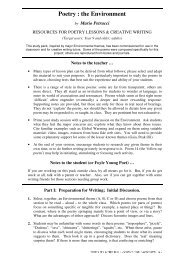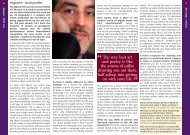Scientific Visualizations: Bridge-Building between ... - Mario Petrucci
Scientific Visualizations: Bridge-Building between ... - Mario Petrucci
Scientific Visualizations: Bridge-Building between ... - Mario Petrucci
You also want an ePaper? Increase the reach of your titles
YUMPU automatically turns print PDFs into web optimized ePapers that Google loves.
284 MARIO PETRUCCI<br />
even as close analogy) are therefore immediately felt. We can either take this<br />
as crushing evidence of the pointlessness of the exercise, or turn that very<br />
insufficiency to advantage, using it to investigate how and why we might<br />
dissect a text for distinguishable qualities, or as an incentive to test and<br />
deepen the Visualizing process itself. This requires an open and inventive<br />
responsiveness that is often its own reward. It can also yield fascinating<br />
results. Indeed, my particular version of intra-textuality emerged, and was so<br />
labelled, partly because the spectrum needed something at its non-explicit end,<br />
but also (later) because many students who rapidly got to grips with explicit<br />
intertextuality were less sure about what was going on at the implicit limit.<br />
This uncovered an exciting area of discourse, eventually leading me to offer a<br />
means of approaching and negotiating (through gradations or fine structure)<br />
those regions of intertextuality they were finding less obvious. What is<br />
sought here — at least initially — is an illuminating variety of access and<br />
interpretation, rather than theoretical rigour or modelling capability at all<br />
costs. Too rigid an adherence to the details of the science would, I feel, have<br />
held this process back. In any case, scientific stringency is often misplaced<br />
among the plural purposes to which such a Visualization might be put.<br />
Figure 2 was never intended to function, within literary studies, as some<br />
mimetic equivalent to the electromagnetic spectrum. It opens up productive<br />
questions more than it closes in on any final answer. In this kind of work, a<br />
Visualization and its target (for analogy) are best seen as siblings, not clones.<br />
(I shall say more about the limitations, and possibilities, of visual analogy in<br />
the section ‘Dangers; opportunities’ later.)<br />
Further discussion on the spectral analogy is available elsewhere (<strong>Petrucci</strong><br />
2001a, 2001b). In spite of its dualistic assumptions and its speculative,<br />
provisional nature, this analogy has helped to kick-start seminar debates on<br />
intertextuality that have incorporated a variety of theories and approach,<br />
from Barthes to Pope (1995). Not only has it raised issues around how one<br />
maps out intertextuality in the first place, it has also focussed attention on<br />
what exactly is meant by any given (or mooted) intertextual quality. It has<br />
even been used — albeit at full stretch — to broach the difficult subject of<br />
authorship and originality, with (for example) the explicit extreme stressing<br />
text as derived object and the intra-textual regime suggesting a unique, willed<br />
writing-subject. Tutors may substitute preferred or alternative interpretations<br />
here; but, whatever the chosen slant, it does students no harm to visit, from<br />
this freshly analogic angle, the intra-textual dark matter of our linguistic<br />
universe.<br />
Crosstalk, mutation, chaos<br />
The following figures further illustrate my early attempts to establish analogies<br />
that qualify, to some degree, as <strong>Visualizations</strong> across disciplines: that is,<br />
they store, visually, some recognizable pattern of characteristics, some parallel<br />
set of relationships, however basic, which illuminates not only the sourced<br />
(scientific) situation but also the targeted aspect of (here) textual reception.<br />
The examples presented certainly function as visual analogies, and therefore<br />
represent possible overlaps <strong>between</strong> relevant bubbles in conceptual space,<br />
INTERDISCIPLINARY SCIENCE REVIEWS, Vol. 36 No. 4, December, 2011


